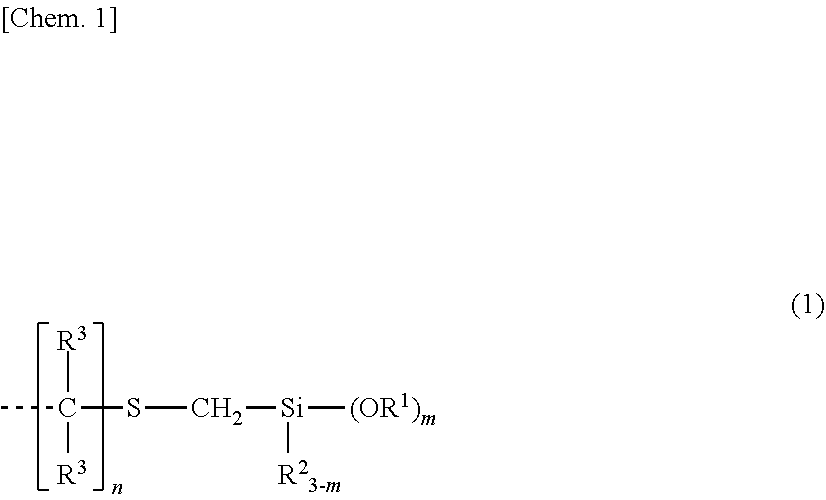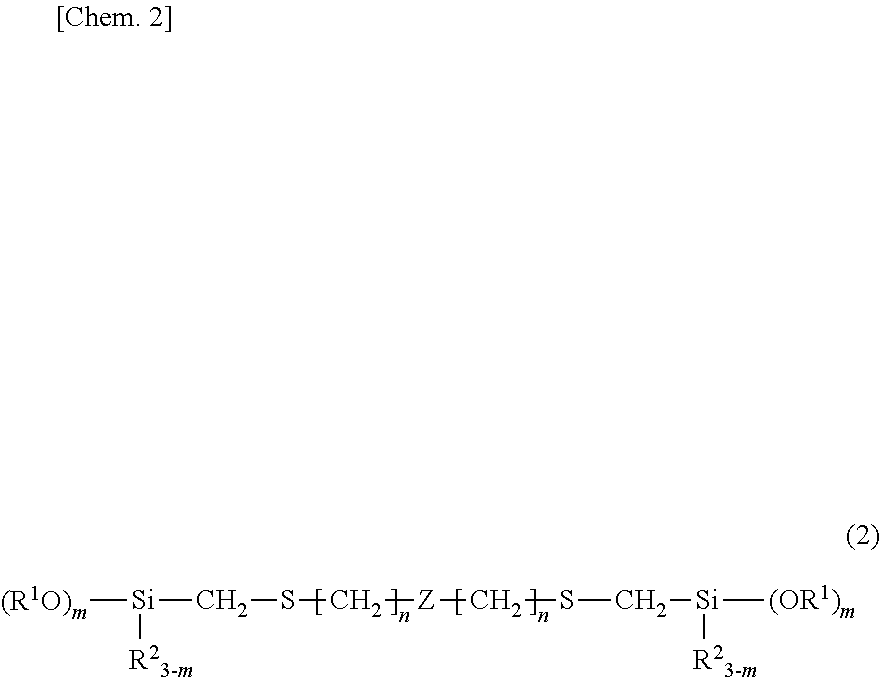Organosilicon compound and method for producing same
a technology of organic compounds and compounds, applied in the field of organic compounds, can solve the problems of less curable compositions, less reactive with airborne moisture, less cureable compositions, etc., and achieve the effects of improving properties, fast cure, and improving cure efficiency
- Summary
- Abstract
- Description
- Claims
- Application Information
AI Technical Summary
Benefits of technology
Problems solved by technology
Method used
Image
Examples
example 1-1
[Example 1-1] Synthesis of Organosilicon Compound 1
[0083]A 200-mL separable flask equipped with a stirrer, reflux condenser and thermometer was charged with 100 g (0.015 mole as terminal vinyl functionality) of a both end vinyl-containing dimethylpolysiloxane compound having a Mn of 13,600 and 2.6 g (0.015 mole as mercapto functionality) of mercaptomethyltrimethoxysilane and heated at 90° C. Then 0.1 g of 2,2′-azobis-2-methylbutyronitrile was added to the contents, which were stirred at 90° C. for 3 hours. On 1H-NMR analysis, the time when the peaks assigned to vinyl and mercapto groups on the reactants disappeared completely and instead, the peak assigned to the desired organosilicon compound was detected was regarded the end of reaction.
[0084]The reaction product was a colorless transparent liquid and had a Mn of 15,200 and a viscosity of 610 mPa·s.
example 1-2
[Example 1-2] Synthesis of Organosilicon Compound 2
[0085]A 200-mL separable flask equipped with a stirrer, reflux condenser and thermometer was charged with 100 g (0.015 mole as terminal vinyl functionality) of a both end vinyl-containing dimethylpolysiloxane compound having a Mn of 13,600 and 2.3 g (0.015 mole as mercapto functionality) of mercaptomethyldimethoxymethylsilane and heated at 90° C. Then 0.1 g of 2,2′-azobis-2-methylbutyronitrile was added to the contents, which were stirred at 90° C. for 3 hours. On 1H-NMR analysis, the time when the peaks assigned to vinyl and mercapto groups on the reactants disappeared completely and instead, the peak assigned to the desired organosilicon compound was detected was regarded the end of reaction.
[0086]The reaction product was a colorless transparent liquid and had a Mn of 14,800 and a viscosity of 590 mPa·s.
example 1-3
[Example 1-3] Synthesis of Organosilicon Compound 3
[0087]A 200-mL separable flask equipped with a stirrer, reflux condenser and thermometer was charged with 100 g (0.015 mole as terminal vinyl functionality) of a both end vinyl-containing dimethylpolysiloxane compound having a Mn of 13,600 and 3.2 g (0.015 mole as mercapto functionality) of mercaptomethyltriethoxysilane and heated at 90° C. Then 0.1 g of 2,2′-azobis-2-methylbutyronitrile was added to the contents, which were stirred at 90° C. for 3 hours. On 1H-NMR analysis, the time when the peaks assigned to vinyl and mercapto groups on the reactants disappeared completely and instead, the peak assigned to the desired organosilicon compound was detected was regarded the end of reaction.
[0088]The reaction product was a colorless transparent liquid and had a Mn of 15,900 and a viscosity of 550 mPa·s.
PUM
| Property | Measurement | Unit |
|---|---|---|
| viscosity | aaaaa | aaaaa |
| viscosity | aaaaa | aaaaa |
| viscosity | aaaaa | aaaaa |
Abstract
Description
Claims
Application Information
 Login to View More
Login to View More - R&D
- Intellectual Property
- Life Sciences
- Materials
- Tech Scout
- Unparalleled Data Quality
- Higher Quality Content
- 60% Fewer Hallucinations
Browse by: Latest US Patents, China's latest patents, Technical Efficacy Thesaurus, Application Domain, Technology Topic, Popular Technical Reports.
© 2025 PatSnap. All rights reserved.Legal|Privacy policy|Modern Slavery Act Transparency Statement|Sitemap|About US| Contact US: help@patsnap.com



